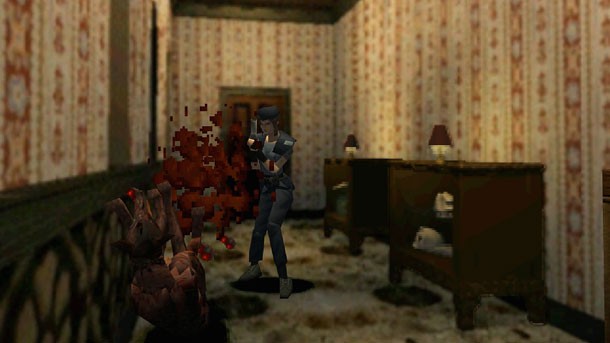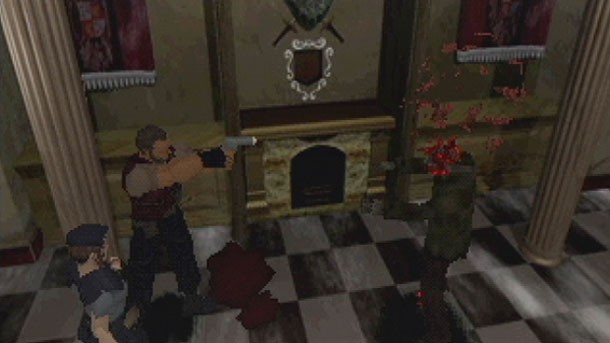Please support Game Informer. Print magazine subscriptions are less than $2 per issue
The Essentials – Resident Evil

The Essentials is Game Informer's weekly feature that takes a look at the most important games the industry has to offer. These games aren't just a ton of fun: Their quality, innovation, and industry influence make them must-play experiences for anyone who wants a greater appreciation of our interactive medium.
This weekend we’re examining Resident Evil. The third-person horror game wasn’t the first-ever horror game by a longshot, but it was so effective and popular that the series has become synonymous with the genre. In fact, Capcom introduced the game to players using term “survival horror”, coined by the developer to describe the innovative game. Resident Evil combined the PlayStation’s then-impressive 3D capabilities with horrifying, unpredictable monster locations and unforgettably bizarre puzzles. These elements, along with demanding strict resource management from players, coalesce into one of the most influential games of all time.
Release Year: 1996 (original), 2002 (remake)
Publisher: Capcom
Developer: Capcom
Released For: PlayStation, Sega Saturn, PC, GameCube, Wii, PS3, PS4, PSP, Vita, Xbox One
Resident Evil released in 1996, borrowing inspiration from Capcom’s Japan-only NES horror RPG, Sweet Home. Resident Evil creator Shinji Mikami took now-iconic elements from Sweet Home such as inventory management, the mansion setting, and even the interstitial sequences with close-ups on doorways. However, Mikami ditched Sweet Home’s top-down perspective and role-playing features, shifting the focus of Resident Evil to atmospheric, 3D action.
The platform-defining PlayStation game was stunning for its time. After the corny live-action intro cinematic where members of the elite S.T.A.R.S. (Special Tactics and Rescue Squad) escape into a mysterious mansion, players are introduced to its foreboding interior. Muted red carpeting stretches from the entrance up a wide set of stairs, spreading out along a balcony toward multiple doorways, hinting at the mansion’s impressive and intimidating sprawl from the start.

Capcom managed such detailed backgrounds thanks to a technique involving 3D character models superimposed over pre-rendered, static backgrounds. The development strategy not only allowed the mansion to appear unsettlingly realistic for the time, but required the fixed camera angles to change since the entire environment wasn’t created in 3D. The result was a paranoia-inducing security-cam-feed-style view. This allowed the camera to focus on objects in the environment rather than the player themselves, setting up memorable scares like the zombie dog leaping through a window. It also kept players on their toes, because one of the undead could be shambling around any blind corner.
Resident Evil’s iconic camera angles and environment design also forced Capcom to get creative with the control scheme. The “tank controls” are the part of the game that have aged the least gracefully, but thankfully Capcom updated the HD remake for the GameCube with a more modern control scheme (along with new enemies, environments, and puzzles). At the time of its release, however, the limiting controls added an extra element of challenge to the game, handicapping players in a way that ratcheted up the tension.
Watch us play through the original Resident Evil and the GameCube remake on Super Replay
Speaking of tension, battling the zombified humans, dogs, spiders, and other scientifically engineered beasts was made more suspenseful thanks to the mansion’s limited resources. Gunning down every enemy wasn’t only unsafe, it was unwise, unless you liked the feeling of running around the creepy halls with an empty pistol. Being forced to choose your battles and carefully aim your shots placed extra significance on every bullet and shotgun shell, making players constantly agonize over their dwindling ammo and carefully consider their path through the mansion.
Players also had to manage their own limited inventory space, swapping out items between their character and a series of connected storage boxes. Is the pistol worth bringing to the fight with a giant snake? How many healing items will you need to get past that leaping, clawed hunter? Having to make the best of a difficult situation is part of what makes the early Resident Evil games so great.

Capcom succeeded in making players feel like they were enduring a nightmarish situation more than other horror games of the time, and part of that comes from the lethal enemies and manual save system. Players must hunt down ink ribbons and use them at typewriters scattered throughout the mansion in order to save. The save system created a real omnipresent risk. The bold and stupid are punished for waiting too long between saves, while cowards that compulsively save could run out of ink ribbons when they truly need them. Earning your checkpoints is something that’s only recently come back into style with games like From Software’s Souls series, Creative Assembly’s Alien: Isolation, and Yacht Club’s Shovel Knight.
Dying is generally frustrating in any game, but seeing likeable protagonists Jill Valentine or Chris Redfield get decapitated or eaten alive by enemies was especially brutal punishment for failure. The story of these special police agents was on par with b-horror films of the ‘80s, made even cheesier by the laughably bad voice acting (“You were almost a Jill sandwich”). Nevertheless, the inherent intrigue of the mansion combined well with the plot involving a S.T.A.R.S. double-crosser, the devious pharmaceutical company Umbrella, and a secret lab hidden beneath the mansion. Cryptic memos and the journals of the dead scattered across the estate also helped flesh things out. Reading the slow descent of a mansion resident succumbing to the T-virus is now an iconic element from the series.

The S.T.A.R.S. team made for a quirky and distinct cast, but the mansion comes to feel like a character itself after spending hours exploring its secrets. Keys and trinkets are strewn across the premises, setting up a selection of odd puzzles that oftentimes required some clever thinking. Some puzzles are straightforward, like using the “Moonlight Sonata” sheet music to play the song on a piano and open a hidden passageway. Another brainteaser asks players to follow clues in a chemistry report to create an herbicide that can weaken a monstrous plant. The variety and esoteric nature of these puzzles made them a welcome distraction from the horrors lurking the mansion halls, proving horror fans want a mix of action and adventure game elements in their horror.
Resident Evil not only continued to iterate on the successful core formula for years to come, it spawned a long line of copycat horror games attempting to recreate the careful balance of scares, limited resources, and atmospheric locales. Not even Capcom’s own Dino Crisis, which borrowed Resident Evil’s tension, deadly predators, and similar camera angles could match the frightful magic of the original. It says a lot that the GameCube remake of this PlayStation classic, which closely adheres to the core formula, has stood the test of time with the recent HD update. Resident Evil only became the industry influencer and juggernaut series it is today because of the impressive foundation it was built upon.
For more of the Essentials, click the banner below.











